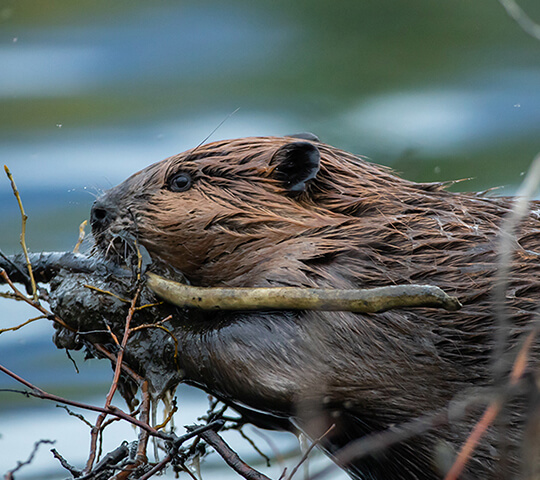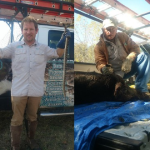Beavers love to build dams to make comfortable home to raise their families, as well as protect themselves from predators. Unfortunately, these dams can cause unwanted water build up and flooding, as well as destruction of nearby trees. Trapping and removing beavers is the most common way to alleviate these problems.
The beaver, an industrious and skilled engineer in the animal kingdom, has been long respected for its ability to transform landscapes. However, when they set up shop in human habitats, their talent can turn into a bit of a nuisance.
Appearance
General Characteristics Beavers are the largest rodents in North America. Recognizable by their large, flat tails and sharp incisor teeth, these creatures are impressively built for a life of swimming and wood-chopping.
Coloration/Patterns/Distinctive Markings Beavers possess a rich brown fur that's waterproof and dense, which helps to insulate them in colder water temperatures. Their fur can range from a dark chocolate brown to a more reddish hue. Their large, chisel-like teeth, a notable feature, are orange-tinted due to the iron content that makes them extra strong.
Size/Features Adult beavers can weigh between 30 to 60 pounds, and they typically measure about 3 to 4 feet in length, including the tail. Their webbed hind feet aid in swimming, while their strong, sharp incisors grow continuously, compelling them to constantly gnaw on wood.
Biology
Digestion and Diet Beavers are herbivores, primarily feeding on tree bark, twigs, and aquatic plants. They have a specialized digestive system that breaks down tough cellulose, using certain bacteria in their gut to ferment and digest plant material.
Reproduction Beavers mate for life, typically producing one litter of kits per year. Litters can range from one to four kits. The young beavers stay with their parents for about two years, learning all the essential beaver skills before setting out on their own.
Habitat
Preferred Environments Beavers inhabit freshwater environments such as rivers, streams, ponds, and lakes. They're known for building dams using sticks, mud, and stones, which help to create a pond environment for their homes or lodges.
Urban Encounters It's not uncommon to find beavers in urban areas where freshwater habitats are available. They might be spotted in city ponds, streams, or even drainage ditches. Their dam-building can lead to flooding, making them less than welcome neighbors.
Behavior
Defensive Mechanisms When threatened, a beaver will slap its tail on the water's surface, creating a loud splash. This serves as a warning to other beavers and as an attempt to frighten potential predators.
Building Techniques Beavers are nature's engineers, constructing dams to raise water levels and protect their lodges. These lodges serve as homes and safe havens from predators. They also dig canal systems to easily transport food and building materials.
Damage/Problems
Diseases While rare, beavers can be carriers of the rabies virus. They can also carry parasites like the giardia lamblia, which causes giardiasis (or "beaver fever") in humans when they consume contaminated water.
Burrowing and Damming Their building projects, while impressive, can lead to significant property damage. Damming can flood vast areas, destroying landscapes, crops, and even structures. Their burrowing can weaken riverbanks or levees, posing risks to the surrounding areas.
Structural Damage Beavers are known to cut down trees which can fall on buildings, fences, or powerlines. Their constant need to gnaw can also target and damage wooden structures like decks, sheds, or docks.
Trapping & Removal
Safe Handling It's essential to approach beavers with caution. They have powerful teeth and can become aggressive if cornered or threatened. It's always recommended to employ professionals like AAAC Wildlife Removal for safe and humane handling.
Deterrence/Prevention/Exclusion
Property Maintenance Regularly inspect your property for signs of beaver activity. Removing fallen trees or branches and ensuring your waterfront is clean can deter beavers from settling in.
Physical Barriers Installing mesh or metal barriers around valuable trees can prevent beavers from gnawing on them. Similarly, barriers can be set up around ponds or water outlets to prevent damming.
Exclusion There are devices and methods, such as water level control structures, that allow water to flow through beaver dams, preventing the area from flooding without harming the beavers. Consulting a professional is crucial to effectively employ these techniques.
Although beaver relocation is illegal in some states, beaver trapping and relocation is one of the best methods of beaver control. And since animal life is valuable, it is important to trap beavers without injuring them. Trapping is occasionally impossible, however, as when beavers get themselves stuck in locations such as window wells.
These situations require professional assistance in removing the animals, since beaver bites can be highly dangerous. Beavers like to die in strange places, and dead beavers can be found in crawlspaces and even in basements. If a dead beaver is not promptly dealt with, the body can cause further damage to your building while attracting other pests.
If you encounter a dead beaver on your property, contact a wildlife professional who can remove the body and then clean and deodorize the area.At AAAC Wildlife Removal, we are your beaver control specialists. If you require beaver control or removal, contact the professionals at AAAC Wildlife Removal today.



















































